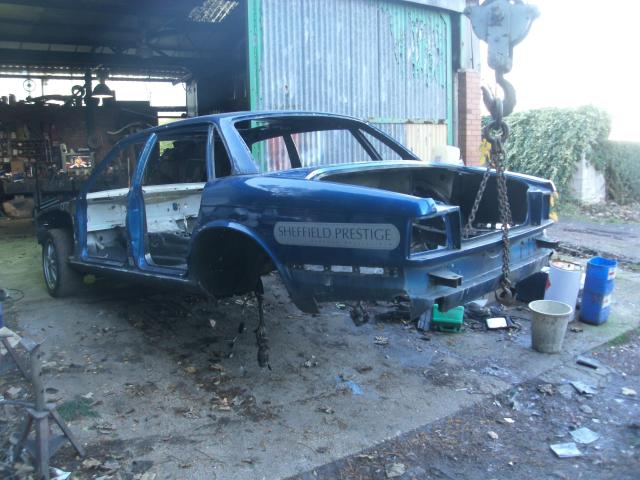LISTER XJ40
The Lister XJ40 enjoyed a torrid 2013, but one of the features of the season was the persistent and confusing failure of the car’s engine management system. That replacing the entire engine loom and ECU cured the fault taught us much, but despite even that, the car ended the year with a wiring glitch at the Birkett when she refused to charge the battery. Running a total loss electrical system is not the plan at all.
We found that fault too, eventually, a dying power cable from alternator to starter, something pretty basic. The cable looked to have been bodged earlier in life. We were never big fans of this car’s wiring, nobody had ever been allowed to get into it properly, and we resolved that it needed to be done.


The pristine and shiny XJ40 with proud owner in April. He doesn't know what we're about to do...

About 2 hours to get to this point. With a hangover. They die much faster than they're born.

And who dare deny it?
It really didn't take long to get to this stage.


There isn't a great deal to these cars. So why do they weigh so much?

Oh no, someone seems to have slipped with the angle grinder. Don't tell Andrew Jeffery.

I was slightly bored, and had a holesaw. Stripped interior reveals the vast cave that is XJ40.

Wheeled to here by hand, then the mercy that is the crane intervenes to lift shell from subframe.

Fresh out of the garage, and largely denuded of all superflous parts.

"They don't look like much when you scrape 'em off your boot." Points if you name the film. PoiJJ

Pick her up a little to go under for the last of the fuel and brake lines, and that dreaded asbestos heat shield.

I hope Bear remembers to turn left for the blasters, and not right to the scrapyard....
The screwdriver languidly hanging out of the body is because the car was rotten enough to let me.
We also knew that the car needed some serious welding, it is an old Jaguar after all, and they don’t not rot merely because they’re on track. Our to-do list was so long that there was really only one sensible solution. Bare shell rebuild.
Now, we didn’t exactly tell the Jeffery clan what we had in mind. They had various suggestions, including reshell, reshell into an X300, reshell into an XJS, but that didn’t sit well with us, the car has a certain identity to it as it is. It started life as an early XJ40 – indeed some of the features to the shell suggest that there were changes to the car at source – then Lister got their paws on it to make it the first 4-litre AJ6, added that now slightly grotty tubular exhaust, and screwed a big brass plaque on the dash. Then it became a racing car.
The plaque and the manifold are all that is left of that, but you can’t ignore the fact that this was a Lister, they only ever did 3 of these, and shooting the shell down to the scrapyard didn’t seem like a plan to us. If we’re going to reshell a car, we might was well take a run at repairing this one. Anyone who has seen our XJS projects knows that there is little we cannot weld up, and this car really isn’t that bad.
So, whilst they weren’t looking, we took the car apart. I mean apart, everything. Doors, wings, bonnet, boot, and bodykit were gone in a single, idle November Sunday morning. Out came the cooling system, then the rear subframe. Once the subframe was clear, the tank fell out. The cage came apart, then with the Saturday assistance of a David, all the wiring jumped out of the car.
Wiring removal was not as simple as it looked, the cage had been installed over the wiring loom, which had to be cut to get it out. Snakes of fat cable make their own serpentine sound as they slither through holes, the noise punctuated by the occasional curse of all Jaguar racing car preparers everywhere, a profanity-based plea for understanding of why the hell they did this when they designed the car. There are some odd choices that no doubt make sense when assembling the car on a production line, but which are a royal pain in the arse when taking it apart. How dare they not plan for amateur mechanics 30 years down the line? Rude.
This is the first time, ever, that this car has been fully apart. It drove in here, however many years ago, as a road car with a cage in it. It’s going to leave here as a full-on racing car, so nothing superfluous is going back. We know what a difference this process makes.
Rear shocks fell out, prop and handbrake, dashboard, seat, belts, extinguisher system. Heater and blowers jumped out, they’re not going back, another 14kg saved. Rear window is carefully cut out. Screen was already broken, so that was less carefully cut out.
All the chrome trim fell off, carefully. What is now left is a giant wheelbarrow, indeed Bear and I can move the car about like this by picking up the rear by hand. If Bear’s had his Weetabix. We had to do it this way to get it in range of the crane, which can’t quite get inside the garage. We have a crane inside, and a mobile crane outside, but you have to transition from one to the other, and that’s what Bear is for. Once in place, last out are the front subframe and engine, which come out as one piece, and we lift the shell off them.
Two more boxes of bits that certainly aren’t going back are stuffed and weighed, another 7kg there. The original fuel tank, if swapped for a smaller, alloy version, will yield another 12kg. We’re already up to 52kg of weight loss, and we’ve cut no metal.
Looking at it critically, and having tried an alloy fuel tank in place, we calmly took the big angle grinder to the car and cut out the rusty and battered boot floor. It will be going back in, in steel, just not quite the original shape, though we did discover you can still buy the whole piece from Jaguar, for about the same price you could weigh it in for as scrap! We’ll put the new floor back in a bit higher, mostly to let air flow over the diff, partly to allow the exhausts more space, and only partly to save a little weight. We don’t tend to lighten the rear of these things off as far as we might, upsets the balance.














This is about as far as we get before the window opens at our friendly shotblast place, and the big blue boat, still without a name but referred to here as “The Tank” is trailered away for the underbonnet, interior and underside blasting.
When she returns, that’s when the fun begins..
She is now a bare shell. And we can see what we’re up against. To get this monster down to minimum weight, 1350kg including driver, we need to save every last gram we can find. The driver is already pretty light, so it has to be the car. Some things cannot be lightened, and in this case we want to add a few pieces to the rollcage to make the car stiffer and stronger, so we’ll be taking what we can wherever we can find it. That means captive nuts, brackets, looking for pointless pieces of car and ridding the machine of them is high on our list. 8kg of steel is quickly located, without much fanfare, it was simply there. We lost over a kilo merely by moving the rear tow strap.
Fuel and brake lines from underneath, they’re not going back either. Then every last bit of remaining sound deadening, vibration mats, foam from various hidden apertures is all pulled out, fished for, and persuaded to let go. A box of 6kg of this stuff, and bear in mind that’s from a car that has supposedly already been stripped for racing, is swiftly collected.

Fully stripped now, but for the engine and subframe, which will come out downwards in one lump.
The impossible to remove rear quarter windows prised out with ease, because they were bonded to the paint, and the paint wasn’t bonded to the car. The car had been repainted from the original white, and we all know full well that unless you properly flat it down it never sticks, and even the most committed paint guy isn't going to flat down inside the window apertures. Obviously they won't be going back in as glass.
The weight of the wiring we decided could be discarded came in at some 20kg. That's not the total weight of the wiring, that's the weight of the wiring that will be thrown away. This was not the only weight saving, as the car came apart we segregated the components into three piles, one for bits that were going back, one for bits that definitely weren’t, and one for bits that would be modified in some way before going back. The third pile was substantial. That pile will hang around getting holes drilled in it for a few weeks as light work for those evenings that you're not up for the smoke and violence of shell repair.